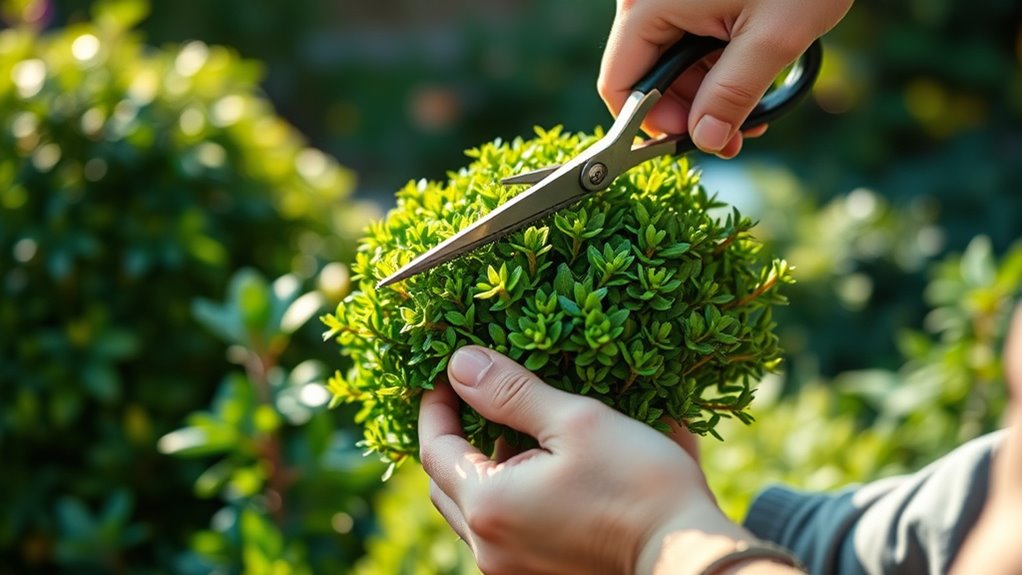To turn leggy plants into showpieces, start by evaluating their natural growth and identifying weak or crossing branches. Prune just above healthy buds to encourage outward growth and a balanced shape. Remove overly long or inward-facing stems to improve air circulation and appearance. Timing is key—late winter or early spring works best—and use sharp tools for clean cuts. With consistent shaping and patience, you’ll transform unruly plants into stunning garden features, and if you keep at it, you’ll discover even more tips.
Key Takeaways
- Assess the plant’s natural growth habit to identify overgrown, crossing, or inward branches needing removal.
- Prune in late winter or early spring with sharp, clean tools for healthy cuts and quick recovery.
- Make cuts just above healthy buds or outward-facing leaf nodes to encourage balanced, outward growth.
- Focus on removing leggy, weak stems and selectively prune to develop a strong, attractive shape.
- Regular, patient pruning promotes a resilient, well-structured plant that enhances garden aesthetics.

Pruning for shape is an essential gardening technique that helps trees and shrubs develop a strong, attractive form. When you prune with purpose, you guide your plants to grow more evenly and aesthetically, transforming leggy, unruly specimens into eye-catching features. If your plants have become elongated and sparse, it’s a sign that they need some strategic shaping to encourage bushier growth and better structure. By removing the right branches at the right time, you give your plants the chance to focus their energy on producing healthy, robust growth, rather than wasting resources on weak or overcrowded stems.
Start by evaluating your plant’s natural growth habit. Look for the most prominent branches and identify those that are overly long, crossing, or growing inward. Your goal is to create a balanced, open shape that allows light and air to circulate freely. When you prune, cut just above a healthy bud or outward-facing leaf node to promote outward growth rather than inward. This technique helps maintain a tidy silhouette and prevents your plant from becoming too leggy or congested. Remember that pruning isn’t about removing every awkward or unruly branch; it’s about selectively encouraging a more pleasing, controlled form.
Evaluate growth habits and prune just above healthy buds for a balanced, open shape.
You should also pay attention to the timing of your pruning. For most deciduous shrubs and trees, late winter or early spring before new growth begins is ideal. This timing minimizes stress on the plant and allows it to recover quickly, putting its energy into developing new, healthy branches. For evergreen plants, light pruning can be done throughout the growing season to maintain shape. Always use sharp, clean tools to make precise cuts, which reduces the risk of disease and ensures cleaner wounds that heal faster. Additionally, understanding the plant’s growth habit and proper pruning techniques can significantly enhance your results and plant health.
As you prune for shape, don’t be afraid to remove more than you think is necessary. It’s better to start conservatively and do additional cuts later if needed. Removing leggy or weak stems not only improves the plant’s appearance but also promotes thicker, sturdier growth. Over time, consistent shaping will help your plants develop a more compact, balanced structure. Keep in mind that patience is key—plants respond gradually, and regular maintenance will lead to more resilient, attractive specimens that become focal points in your garden. With practice and attentiveness, pruning for shape becomes a rewarding way to enhance your landscape’s overall beauty.
Frequently Asked Questions
When Is the Best Time of Year to Prune for Shape?
You should prune for shape during late winter or early spring before new growth begins. This timing allows your plant to recover quickly and encourages strong, healthy branches. Avoid heavy pruning in the heat of summer or late fall, as it can stress your plant. Regular shaping throughout the year helps maintain the desired form, but major cuts are best made during the dormant season for ideal results.
How Do I Prune Without Damaging the Plant?
You want to prune without damaging your plant, so start by using clean, sharp tools to make precise cuts. Think of pruning as a gentle art—always cut just above a node or bud, and avoid removing more than a third of the plant at once. While it might seem delicate, patience and careful technique help your plant recover quickly, turning it into a healthy, attractive centerpiece.
What Tools Are Recommended for Shaping Plants?
You should use sharp, clean tools like pruning shears or scissors for shaping plants. For thicker branches, opt for loppers or a pruning saw. Make sure your tools are sterilized to prevent disease. Always choose the right tool for the branch size, and cut at a slight angle to promote healthy growth. Proper tools help you make precise cuts, ensuring your plant maintains its shape and stays healthy.
Can Pruning Be Used to Control Plant Size Permanently?
Yes, pruning can help control a plant’s size permanently when done correctly. You should regularly trim back new growth and remove any unwanted branches to maintain the desired shape and size. By consistently pruning, you encourage a more compact, bushy growth habit. Keep in mind that some plants may need ongoing maintenance, but proper, targeted pruning will help keep your plant manageable and visually appealing over time.
How Often Should Pruning Be Done for Maintaining Shape?
You should prune your plants every 4 to 6 weeks during the growing season to maintain their shape. Notably, regular pruning can increase plant growth by up to 30%, ensuring your plants stay full and attractive. Keep an eye out for new growth and trim just above leaf nodes to encourage a lush, balanced appearance. Consistent maintenance helps your plants look their best and prevents them from becoming leggy or unruly.
Conclusion
By regularly pruning your plants, you transform leggy, unruly growth into stunning, well-shaped specimens. Imagine you have a tall, spindly rose bush; a few strategic cuts can encourage lush, compact blooms that become the highlight of your garden. Just like a gardener who turned an overgrown shrub into a beautiful topiary, your careful shaping efforts will reward you with a healthier, more attractive plant. Start pruning today, and watch your garden flourish with character and charm.











